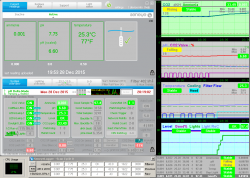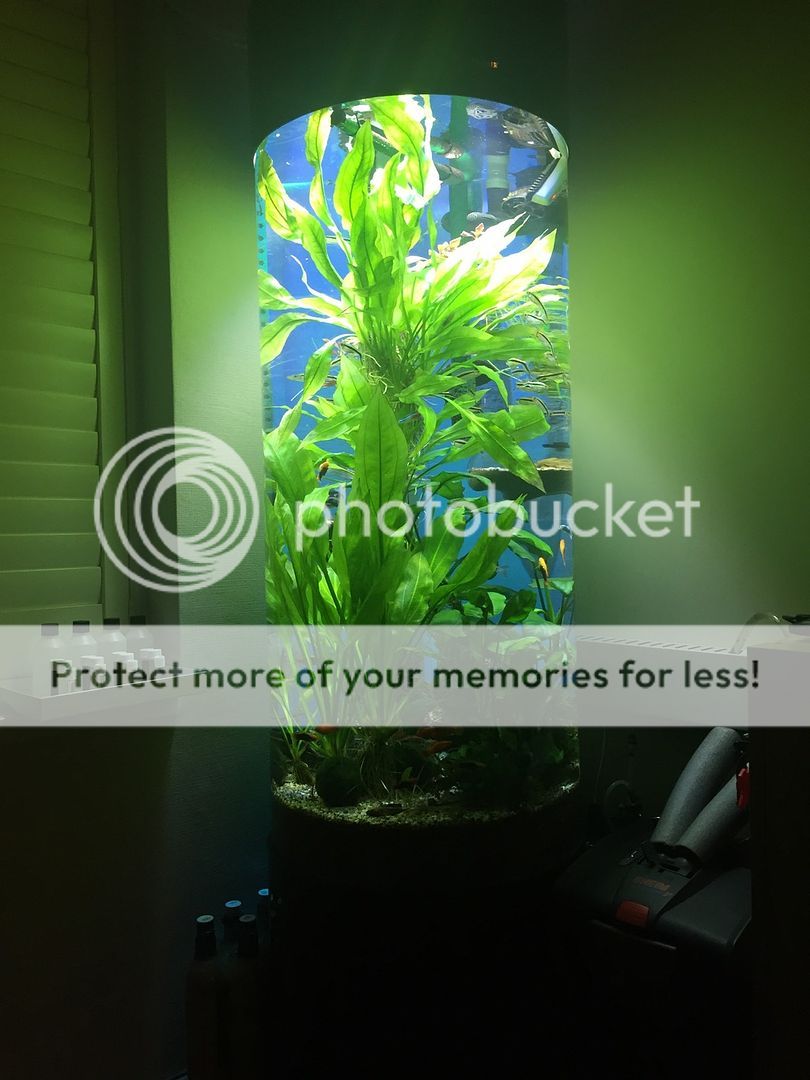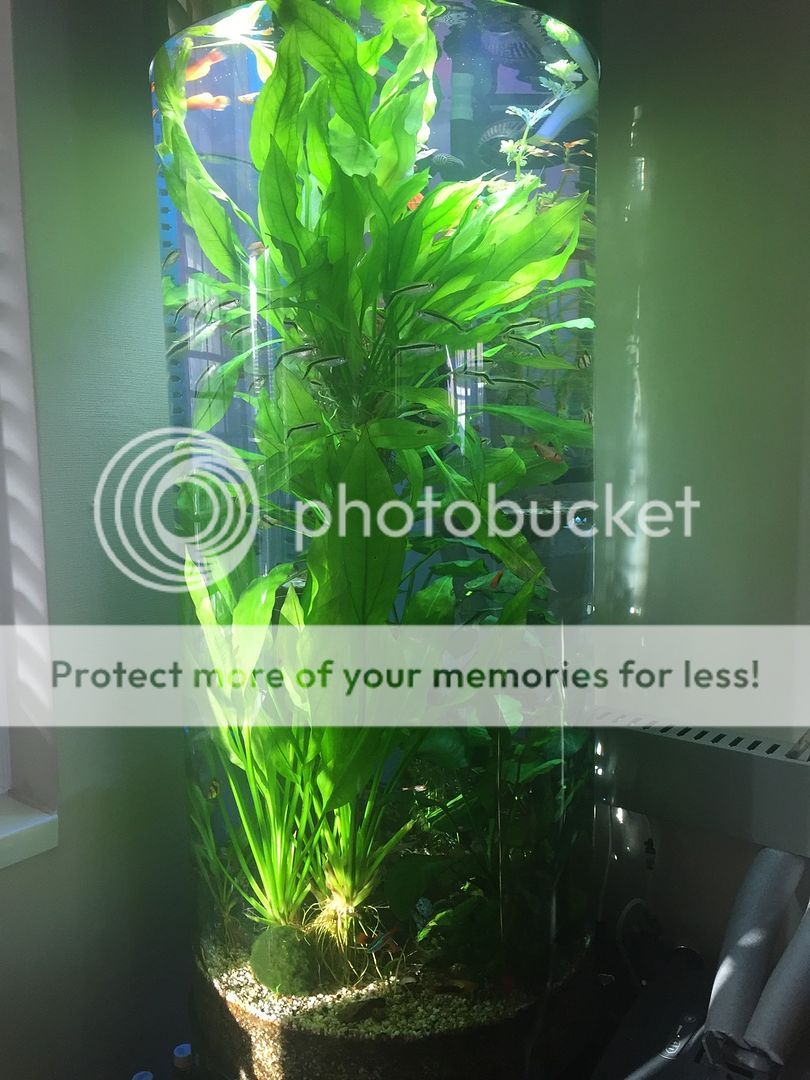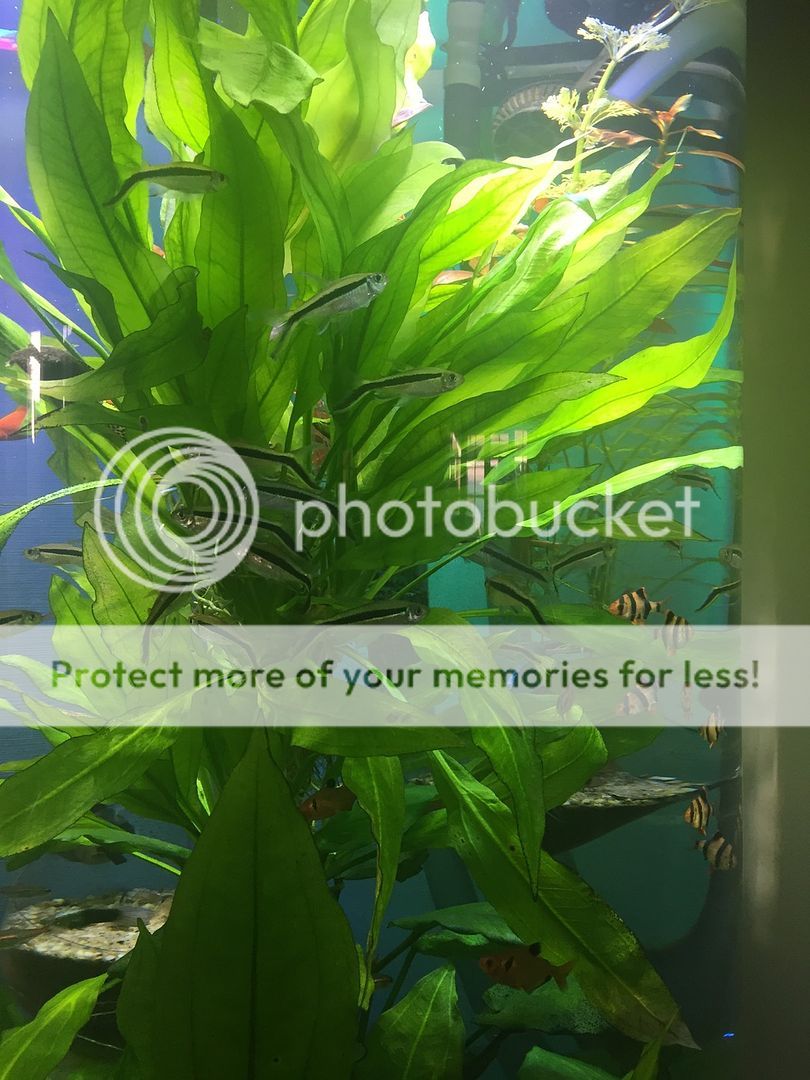cornclose
Fish Fanatic
Hello everyone,
I'm not new as I've been lurking for years, but as you can see I haven't made much in the way of posts here for a while..
Anyhow, I'd thought I'd start a project thread having never really done an aquarium project thread before (although I've done lots of projects!).
So, although this is the start of a project thread, it certainly isn't the start of a project, but more of a mid-term kick-off!
What started out as a strong desire to have a lush, planted freshwater aquarium has resulted in one of the most high-tech tank setups I've ever come across.
Like most, although I've been fish keeping for about 14 years now, I never really truly got to grips with it until I was several years in, and even then one thing I really wanted eluded me - a lush, thickly planted algae-free tank where all and any plant growth outstripped any algae growth and the ability of any fish to eat the plant growth was outstripped by the rate at which the plants grew.
This meant only one thing as I researched things over the years - high filtration, high light, high ferts, high CO2 and large frequent water changes. Of course this can mean high maintenance also, but I decided to start creating an aquarium control system to help me with all of that.
Initially we all start with a simple timer on our lights, and experimenting with photo-periods, which is also where I started. What followed over the next few years has kind of surprised even myself..
I cannot begin to recount every feature my system currently has, and it's still developing continuously as I add more features and refine existing systems, but it's all DIY and built from scratch. So what I'll try to do, as much for my own documentation purposes as for anything else, is to recount the build in multiple threads in more or less the order in which it was developed. Hopefully this will jog my memory as I go and allow me to 'write up' the feature set and how things were done, and also it might help get feedback from others as to better ways of doing things or suggestions of new features (I already have an extensive 'to do' list though!).
I'll start with a quick overview of where it is right now (I will probably come back and add/update info in new posts as I won't cover it all on the first pass..)
The Tank
A 180 litre, tall cylindrical column of water about 1000mm deep (water surface to top of substrate) with a diameter of about 450mm.
As you can imagine, this is a challenging configuration for a planted tank, which probably accounts for the many issues I had in the earlier days (before I knew any better) as due to the depth of the water it is difficult to balance the light conditions to suit the planting.
The Filtration
1x Eheim Professional 3e 600T Thermofilter
1x Fluval U4 internal filter (located in sump)
1x 500ml moving bed filter (located in sump)
The substrate (about 200mm deep) in the main tank also has an air-lift filter which is separately controlled (not used all the time). There is lots of bio media in the sump also, which has in/out flow continuously.
The Heating
1x 210W (built in to the Eheim 3e 600T Thermofilter)
1x 200W glass heater (located in sump)
The Lighting
An all-DIY setup with a combination of;
2x 20W 4200K compact fluorescent tubes
4x 5W 4500K GU10 LEDs
3x 5W 6500K GU10 LEDs
2x 5W 14000K (blue) GU10 LEDs
2x 5W multicolour (RGB) LEDs (phased backdrop effects)
1x 0.5W 14000K (blue) LED (for moonlight/night lighting effects)
The Sump
A DIY sump made from a second-hand Fluval Chi 19 litre display tank. Yes this is only a small sump so does not increase the system volume by much (about 20 litres since it holds a little more water than the 19 litre specification would suggest..) but what it lacks in volume in makes up in other areas as it holds;
A second filter (Fluval U4)
A second heater (200W glass)
A moving bed filter
Lots of additional media
Drop-Checker for manual pH/CO2 checks
It also serves as the basis for the Auto Top-Off and Auto Water-Change systems, acts as a refugium, and a convenient place to dose ferts.
The CO2 System
A DIY system with a few bought-in components. It's a solenoid valve controlled system with a Soda-Stream CO2 supply, regulator, bubble counter, check valves and inline diffuser (inline with main Eheim 3e 600 filter).
Seneye Reef System
Used for temperature, Ammonia, pH, water level and light intensity monitoring, fully interfaced using custom written software to..
The Control System
Custom designed and custom written software operating on Windows PC allied with hardware control via industrial PLC systems with communications over Ethernet. Fully web enabled via VPN connectivity for remote view/control from anywhere in the world (which is handy as I work away occasionally..).
So what does it control ? In brief;
Lighting - switch on and off of all lights to simulate dawn/dusk. Adjustable photo period on/off time settings per day, with ability to skip day(s) or manually override on/off the lighting, if required. The main tank hood which houses the lights is force air cooled by using an automatically controlled cooling fan.
CO2 System - Control on/off the CO2 solenoid valve based upon measured pH and calculated CO2 concentrations (based on the well known pH/KH relationship charts). Adjustable setpoints to control CO2 concentrations to 28ppm (during lights off) to 36ppm (lights on), and anywhere in between if required.
Aeration - via an under-gravel filter bed which is air driven, this can be switched on or off depending upon requirements. Currently only used to provide additional surface agitation in circumstances where the CO2 levels get too high (rarely happens now the control of CO2 concentration is working well, but was added as a safety net in the early days..).
Filter System - Control of the Eheim Professional 3e flow rate and monitoring of the same via Eheim's 'ControlCenter' software using a USB-Serial interface.
Surface Skimmer - yes this is needed for freshwater tanks too. A DIY skimmer solution which is fully controlled and operates mainly at night to remove scum and surface films. Also aids in off-gassing CO2 to keep tank pH stable during night-time plant CO2 production. Gives the water surface that lovely crystal clear glassy look.
Auto Top-Off - addition of fresh top-off water to sump as required by level monitoring devices in the sump and main tank. ATO container is 10 litres and is kept at room temperature and continuously aerated.
Auto Water-Change - a water change system which can change 75 litres of tank water with fresh water automatically, un-attended. This equates to approximately a 30% water change, which is performed twice per week. The water change vessel is aerated and pre-heated to main tank temperature. The water change process takes place slowly over a period of 8-12 hours, usually overnight (although it can be at any time).
Sump - monitor levels in the sump and control based on these. Enable/disable return pump, prevent running dry etc.
Auto Feeder - tank inhabitants are feed automatically using a stock off-the-shelf feeder
Uninterruptible Power Supply (UPS)
A DIY UPS backs the whole system and gives approximately 4-12 hours run time (depending on whether lighting is on or not..) of the entire system should there be a power outage.
I'll leave you with a quick screenshot of the main overview of the system, and I'll add lots more, including photos, when I take them and I update this thread.

I've attached a screenshot too in case the linked image is down.
Bye for now.
I'm not new as I've been lurking for years, but as you can see I haven't made much in the way of posts here for a while..
Anyhow, I'd thought I'd start a project thread having never really done an aquarium project thread before (although I've done lots of projects!).
So, although this is the start of a project thread, it certainly isn't the start of a project, but more of a mid-term kick-off!
What started out as a strong desire to have a lush, planted freshwater aquarium has resulted in one of the most high-tech tank setups I've ever come across.
Like most, although I've been fish keeping for about 14 years now, I never really truly got to grips with it until I was several years in, and even then one thing I really wanted eluded me - a lush, thickly planted algae-free tank where all and any plant growth outstripped any algae growth and the ability of any fish to eat the plant growth was outstripped by the rate at which the plants grew.
This meant only one thing as I researched things over the years - high filtration, high light, high ferts, high CO2 and large frequent water changes. Of course this can mean high maintenance also, but I decided to start creating an aquarium control system to help me with all of that.
Initially we all start with a simple timer on our lights, and experimenting with photo-periods, which is also where I started. What followed over the next few years has kind of surprised even myself..
I cannot begin to recount every feature my system currently has, and it's still developing continuously as I add more features and refine existing systems, but it's all DIY and built from scratch. So what I'll try to do, as much for my own documentation purposes as for anything else, is to recount the build in multiple threads in more or less the order in which it was developed. Hopefully this will jog my memory as I go and allow me to 'write up' the feature set and how things were done, and also it might help get feedback from others as to better ways of doing things or suggestions of new features (I already have an extensive 'to do' list though!).
I'll start with a quick overview of where it is right now (I will probably come back and add/update info in new posts as I won't cover it all on the first pass..)
The Tank
A 180 litre, tall cylindrical column of water about 1000mm deep (water surface to top of substrate) with a diameter of about 450mm.
As you can imagine, this is a challenging configuration for a planted tank, which probably accounts for the many issues I had in the earlier days (before I knew any better) as due to the depth of the water it is difficult to balance the light conditions to suit the planting.
The Filtration
1x Eheim Professional 3e 600T Thermofilter
1x Fluval U4 internal filter (located in sump)
1x 500ml moving bed filter (located in sump)
The substrate (about 200mm deep) in the main tank also has an air-lift filter which is separately controlled (not used all the time). There is lots of bio media in the sump also, which has in/out flow continuously.
The Heating
1x 210W (built in to the Eheim 3e 600T Thermofilter)
1x 200W glass heater (located in sump)
The Lighting
An all-DIY setup with a combination of;
2x 20W 4200K compact fluorescent tubes
4x 5W 4500K GU10 LEDs
3x 5W 6500K GU10 LEDs
2x 5W 14000K (blue) GU10 LEDs
2x 5W multicolour (RGB) LEDs (phased backdrop effects)
1x 0.5W 14000K (blue) LED (for moonlight/night lighting effects)
The Sump
A DIY sump made from a second-hand Fluval Chi 19 litre display tank. Yes this is only a small sump so does not increase the system volume by much (about 20 litres since it holds a little more water than the 19 litre specification would suggest..) but what it lacks in volume in makes up in other areas as it holds;
A second filter (Fluval U4)
A second heater (200W glass)
A moving bed filter
Lots of additional media
Drop-Checker for manual pH/CO2 checks
It also serves as the basis for the Auto Top-Off and Auto Water-Change systems, acts as a refugium, and a convenient place to dose ferts.
The CO2 System
A DIY system with a few bought-in components. It's a solenoid valve controlled system with a Soda-Stream CO2 supply, regulator, bubble counter, check valves and inline diffuser (inline with main Eheim 3e 600 filter).
Seneye Reef System
Used for temperature, Ammonia, pH, water level and light intensity monitoring, fully interfaced using custom written software to..
The Control System
Custom designed and custom written software operating on Windows PC allied with hardware control via industrial PLC systems with communications over Ethernet. Fully web enabled via VPN connectivity for remote view/control from anywhere in the world (which is handy as I work away occasionally..).
So what does it control ? In brief;
Lighting - switch on and off of all lights to simulate dawn/dusk. Adjustable photo period on/off time settings per day, with ability to skip day(s) or manually override on/off the lighting, if required. The main tank hood which houses the lights is force air cooled by using an automatically controlled cooling fan.
CO2 System - Control on/off the CO2 solenoid valve based upon measured pH and calculated CO2 concentrations (based on the well known pH/KH relationship charts). Adjustable setpoints to control CO2 concentrations to 28ppm (during lights off) to 36ppm (lights on), and anywhere in between if required.
Aeration - via an under-gravel filter bed which is air driven, this can be switched on or off depending upon requirements. Currently only used to provide additional surface agitation in circumstances where the CO2 levels get too high (rarely happens now the control of CO2 concentration is working well, but was added as a safety net in the early days..).
Filter System - Control of the Eheim Professional 3e flow rate and monitoring of the same via Eheim's 'ControlCenter' software using a USB-Serial interface.
Surface Skimmer - yes this is needed for freshwater tanks too. A DIY skimmer solution which is fully controlled and operates mainly at night to remove scum and surface films. Also aids in off-gassing CO2 to keep tank pH stable during night-time plant CO2 production. Gives the water surface that lovely crystal clear glassy look.
Auto Top-Off - addition of fresh top-off water to sump as required by level monitoring devices in the sump and main tank. ATO container is 10 litres and is kept at room temperature and continuously aerated.
Auto Water-Change - a water change system which can change 75 litres of tank water with fresh water automatically, un-attended. This equates to approximately a 30% water change, which is performed twice per week. The water change vessel is aerated and pre-heated to main tank temperature. The water change process takes place slowly over a period of 8-12 hours, usually overnight (although it can be at any time).
Sump - monitor levels in the sump and control based on these. Enable/disable return pump, prevent running dry etc.
Auto Feeder - tank inhabitants are feed automatically using a stock off-the-shelf feeder
Uninterruptible Power Supply (UPS)
A DIY UPS backs the whole system and gives approximately 4-12 hours run time (depending on whether lighting is on or not..) of the entire system should there be a power outage.
I'll leave you with a quick screenshot of the main overview of the system, and I'll add lots more, including photos, when I take them and I update this thread.

I've attached a screenshot too in case the linked image is down.
Bye for now.





